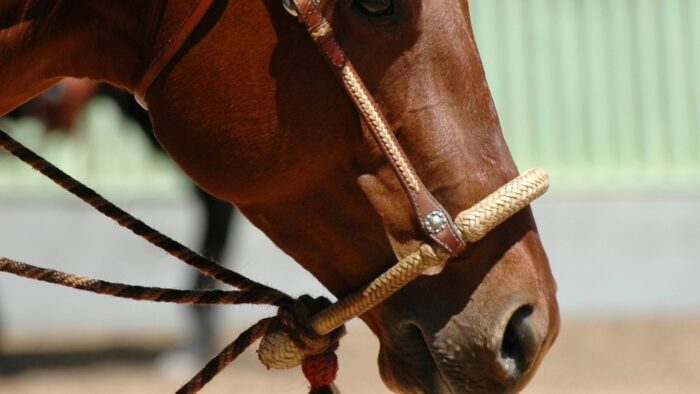Last Updated on March 13, 2023
If you are having problems training with your horse, you may consider swapping to a jumping hackamore bridle. If this is the case, what is the best jumping hackamore bridle to use? Let’s find out!
What is a Jumping Hackamore Bridle?
The tack and equipment that you choose to train and ride your horse in can have a huge impact on the quality of his work. If you want to excel in jumping, you need to have enough control over your horse to guide him both in the direction and speed around the course of jumps. So, this raises the question – is it better to use a bridle with a bit or a hackamore jumping bridle?
Hackamores are bitless bridles split into two main categories, mechanical and nonmechanical hackamores. Many people think that bitless bridles are kinder to the horse, but hackamores can cause significant harm if not used correctly. This particularly applies to mechanical hackamores, which use leverage to apply pressure to the horse’s head.

Hackamore bridles are perfectly acceptable to use when jumping horses. The worldwide governing body for show jumping, the FEI, have ruled that they are competition legal. However, just because they are accepted does not necessarily mean that they are the right choice for you and your horse.
Click here to get info about:
What is The Best Jumping Hackamore Bridle to Use?
If you are considering using a jumping hackamore bridle on your horse, it is important to make sure that it lies within the competition rules for this sport. Some types of hackamore bridles are banned for show jumping. If you compete in other equestrian sports, you may find that the use of hackamore bridles is banned altogether.
Under FEI rules, mechanical shank hackamores are permitted to be used within the competition. The metal shank of the hackamore must never exceed 17 centimeters, and the hackamore must never be used in conjunction with a bit. The hackamore bridle must be fitted correctly and the veterinarian team at the competition has the authority to eliminate the rider if they feel the bridle is causing distress or injury.
Horse riders are not permitted to compete in FEI-level show jumping competitions on a horse wearing a bosal or side-pull style of the hackamore. However, you may find that they are permitted at lower-level competitions, such as local shows. It is important to always check the rules of the show that you are entering beforehand to make sure that your tack and equipment are permitted.
Specialist jumping hackamore bridles are available and it is a good idea to speak to a reputable tack supplier to make sure you get one that is right for you and your horse. They will be able to ensure that you are not only using the right jumping hackamore bridle but also that it is fitted correctly to your horse.
Tory Leather Jumping Hackamore
Does My Horse Need a Jumping Hackamore Bridle?
Whether your horse needs a jumping hackamore bridle will depend on many factors. It is important not to leap changing your horse from a traditional bitted bridle to a hackamore without first consulting with a trainer who is confident in the use of hackamore bridles. In the wrong hands, a hackamore bridle can cause significant pain and discomfort to a horse.
Working with a trainer also has the advantage that they can help your horse understand how to be ridden in a hackamore bridle. If neither you nor your horse has used a hackamore before, this can be a confusing situation!
Your trainer will be able to ride your horse in a hackamore and help him to train a minute before you take over the reins. It is also a good idea to try riding a horse that is already trained in the use of a hackamore before using one on your own horse.
If your horse struggles to accept issued a traditional bit, then a hackamore bridle may be the right one for him. However, if you are having control issues or experiencing problems training your horse, it may be something other than the bridle which is at the root of the problem. Working alongside a trainer can help you rule out other problems before committing to changing to a jumping hackamore bridle.
The Western Hackamore Bridle
Hackamores are also used in certain western disciplines. The most common type of western hackamore is the bosal, which is thick and oval-shaped.
Bosals have two knots at the knot end of the bosal that makes for a continuous rein. Bosals are often used in western riding for training or showing young horses in competitions. They typically do not offer as much leverage as mechanical hackamores do.
Mechanical hackamores may also be used in certain western disciplines. They typically have a longer shape to provide more leverage. Mechanical hackamores have the same principle as curb bit and can be used for English and western riding.
Western side pulls are a type of bridle that combines a bosal and a bitless bridle. They are not considered a true hackamore and tend to fall in more along the lines of bitless bridles. Side pulls act similarly to a snaffle and is a common type of bridle for training purposes.
The reins on a western side pull bridle attach directly to the noseband, allowing the rider to communicate through direct rein aids. How severe a side pull bridle depends on the thickness of the noseband.
What is a Bitless Bridle?
A bitless bridle is another alternative to a traditional bridle with a bit. A bitless bridle works similarly to a halter as it applies pressure across a horse’s head.
While hackamores are a type of bridle with no bit, a bitless bridle is another type of bridle that does not use a bit. It can be confusing to understand the differences, however, a bitless bridle does differ from a hackamore. Bitless bridles are a relatively new invention.
The English hackamore bridle replaces the noseband and bit of the bridle. It features shanks to provide leverage and sometimes includes a curb chain.
Bitless bridles feature side pulls or rings to which the reins are attached. Bitless bridles apply pressure to the horse without the use of a shank. While bitless bridles are typically gentle they can be harsh in the wrong hands.
How to Fit a Hackamore to a Horse
Just like with a traditional bridle, it is vital you properly fit a hackamore for proper comfort and communication. An ill-fitting hackamore can provide discomfort and even behavioral problems for your horse.
Hackamores typically come in different sizes such as pony, cob, horse (full), and extra large (draft). The sizes are made to appropriately fit different horses, as one size does not fit all.
Before purchasing a hackamore, read the sizing chart and then measure your horse accordingly to the chart. The hackamore should fit comfortably on the horse so it does not pinch or does not hang loosely.
The hackamore cheek pieces are shorter than a traditional bridle as the hackamore should rest similar to where a noseband goes on a traditional bridle. Mechanical hackamore fitting is quite similar to a traditional bridle in other aspects of the bridle such as the crown piece, browband, and throatlatch.
It is always a good idea to seek help from a trainer when fitting a hackamore to your horse. They can help ensure that it is fitted correctly so it will be comfortable for your horse.
Summary
So as we have learned, the only type of jumping hackamore bridle authorized for use in competition by the FEI is a mechanical hackamore. The shanks of the hackamore must not exceed 17 centimeters and the hackamore is not permitted to be used in conjunction with a bitted bridle. Non-mechanical hackamore bridles such as bosal and side-pulls are not authorized for use in equestrian show-jumping competitions.
We’d like to hear your thoughts on the best jumping hackamore bridle for horses! Are you a big fan of riding horses in a hackamore bridle instead of a traditional bitted bridle? Or perhaps you’ve got some questions about the best way to train your horse to be ridden in a jumping hackamore bridle? Leave a comment below and we’ll get back to you!
FAQs
Is a hackamore better than a bitless bridle?
A hackamore is not necessarily better than a bitless bridle, but it is very different in the way it works. Different types of bits and bridles all suit different horses and different types of work. Hackamores tend to be better for horses that struggle to accept a bit inside their mouths.
Can I ride my horse in a hackamore?
Most horses can be trained to be ridden in a hackamore. However, if you have never used a hackamore bridle before, it is important to work with a trainer who has experience in this type of tack. They will help both you and your horse become accustomed to being ridden in a hackamore.
Do hackamores hurt horses?
Many people think of hackamores as gentler than a bridle with a bit, but in the wrong hands they can hurt horses. This is because the hackamore bridle applies pressure at certain points on the horses head, which can cause pain and discomfort.
Are hackamores better than bits?
Hackamores are not necessarily better than bits, they're just different. Every horse is an individual and some will work better in a hackamore whilst others are more comfortable with a traditional bitted bridle

Kate Chalmers is a qualified veterinary nurse who has specialized in horse care for the vast majority of her career. She has been around horses since she was a child, starting out riding ponies and helping out at the local stables before going on to college to study Horse Care & Management. She has backed and trained many horses during her lifetime and competed in various equestrian sports at different levels.
After Kate qualified as a veterinary nurse, she provided nursing care to the patients of a large equine veterinary hospital for many years. She then went on to teach horse care and veterinary nursing at one of the top colleges in the country. This has led to an in-depth knowledge of the care needs of horses and their various medical ailments, as well as a life-long passion for educating horse owners on how to provide the best possible care for their four-legged friends.
Kate Chalmers BSc (Hons) CVN, Dip AVN (Equine) Dip HE CVN EVN VN A1 PGCE

